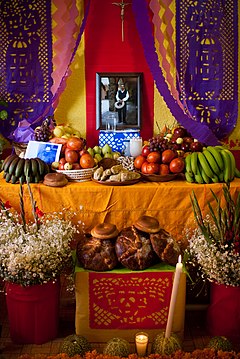| Day of the Dead | |
|---|---|
 | |
| Observed by | Mexico, and regions with large Mexican populations |
| Type |
|
| Significance | Prayer and remembrance of friends and family members who have died |
| Celebrations | Creation of home altars to remember the dead, traditional dishes for the Day of the Dead |
| Begins | November 1 |
| Ends | November 2 |
| Date | November 2 |
| Next time | 2 November 2025 |
| Frequency | Annual |
| Related to | All Saints' Eve / All Hallows' Eve, All Saints' Day / All Hallows' Day, All Souls' Day[1] |
The Day of the Dead (Spanish: Día de (los) Muertos)[2][3] is a holiday traditionally celebrated on November 1 and 2, though other days, such as October 31 or November 6, may be included depending on the locality.[4][5][6] The multi-day holiday involves family and friends gathering to pay respects and remember friends and family members who have died. These celebrations can take a humorous tone, as celebrants remember amusing events and anecdotes about the departed.[7] It is widely observed in Mexico, where it largely developed, and is also observed in other places, especially by people of Mexican heritage. The observance falls during the Christian period of Allhallowtide.[1] Some argue that there are Indigenous Mexican or ancient Aztec influences that account for the custom, though others see it as a local expression of the Allhallowtide season that was brought to the region by the Spanish; the Day of the Dead has become a way to remember those forebears of Mexican culture. The Day of the Dead is largely seen as having a festive characteristic.[8]
Traditions connected with the holiday include honoring the deceased using calaveras and marigold flowers known as cempazúchitl, building home altars called ofrendas with the favorite foods and beverages of the departed, and visiting graves with these items as gifts for the deceased.[9] The celebration is not solely focused on the dead, as it is also common to give gifts to friends such as candy sugar skulls, to share traditional pan de muerto with family and friends, and to write light-hearted and often irreverent verses in the form of mock epitaphs dedicated to living friends and acquaintances, a literary form known as calaveras literarias.[10]
In 2008, the tradition was inscribed in the Representative List of the Intangible Cultural Heritage of Humanity by UNESCO.[11]
- ^ a b c Foxcroft, Nigel H. (October 28, 2019). The Kaleidoscopic Vision of Malcolm Lowry: Souls and Shamans. Rowman & Littlefield. p. 130. ISBN 978-1-4985-1658-7.
However, owing to the subjugation of the Aztec Empire by the Spanish conquistador, Hernan Coretes in 1519–1521, this festival increasingly fell under Hispanic influence. It was moved from the beginning of summer to late October—and then to early November—so that it would conicide with the Western Christian triduum (or three-day religious observance) of Allhallowtide (Hallowtide, Allsaintide, or Hallowmas). It lasts from October 31 to November 2 and comprises All Saint's Eve (Halloween), All Saints' Day (All Hallows'), and All Souls' Day.
- ^ "Día de Todos los Santos, Día de los Fieles Difuntos y Día de (los) Muertos (México) se escriben con mayúscula inicial" [Día de Todos los Santos, Día de los Fieles Difuntos and Día de (los) Muertos (Mexico) are written with initial capital letter] (in Spanish). Fundéu. October 29, 2010. Archived from the original on September 26, 2020. Retrieved November 4, 2020.
- ^ "¿'Día de Muertos' o 'Día de los Muertos'? El nombre usado en México para denominar a la fiesta tradicional en la que se honra a los muertos es 'Día de Muertos', aunque la denominación 'Día de los Muertos' también es gramaticalmente correcta" ['Día de Muertos' or 'Día de los Muertos'? The name used in Mexico to denominate the traditional celebration in which death is honored is 'Día de Muertos', although the denomination 'Día de los Muertos' is also grammatically correct] (in Spanish). Royal Spanish Academy Official Twitter Account. November 2, 2019. Archived from the original on April 2, 2020. Retrieved November 4, 2020.
- ^ Sacred Places of a Lifetime. National Geographic. 2008. p. 273. ISBN 978-1-4262-0336-7.
Day of the Dead celebrations take place over October 31 ... November 1 (All Saints' Day), and November 2.
- ^ Skibo, James; Skibo, James M.; Feinman, Gary (January 14, 1999). Pottery and People. University of Utah Press. p. 65. ISBN 978-0-87480-577-2.
In Yucatan, however, the Day of the Dead rituals occur on October 31, November 1, and November 6.
- ^ Arnold, Dean E. (February 7, 2018). Maya Potters' Indigenous Knowledge: Cognition, Engagement, and Practice. University Press of Colorado. p. 206. ISBN 978-1-60732-656-4.
pottery as a distilled taskscape is best illustrated in the pottery required for Day of the Dead rituals (on October 31, November 1, and November 6), when the spirits of deceased ancestors come back to the land of the living.
- ^ Palfrey, Dale Hoyt (1995). "The Day of the Dead". Día de los Muertos Index. Access Mexico Connect. Archived from the original on November 30, 2007. Retrieved November 28, 2007.
- ^ "Dia de los Muertos". National Geographic Society. October 17, 2012. Archived from the original on April 8, 2019. Retrieved April 8, 2019.
- ^ "Dia de los Muertos". National Geographic Society. October 17, 2012. Archived from the original on November 2, 2016. Retrieved November 2, 2016.
- ^ Chávez, Xóchitl (October 23, 2018). "Literary Calaveras". Smithsonian Voices. Archived from the original on September 29, 2021. Retrieved September 29, 2021.
- ^ "Indigenous festivity dedicated to the dead". UNESCO. Archived from the original on October 11, 2014. Retrieved October 31, 2014.